Employee Turnover: Understanding Its Impact on Organizations and Strategies for Retention

The Employee Turnover! Attrition refers to the natural reduction in the size of a workforce over time due to resignations, retirements, or other reasons. It is the gradual reduction of employees without actively replacing them.
Voluntary Turnover
When employees leave the organization voluntarily, it is considered voluntary turnover. This can happen for various reasons, such as career advancement opportunities, dissatisfaction with the job or work environment, or pursuit of better compensation and benefits elsewhere.
Involuntary Turnover
Involuntary turnover refers to the termination or dismissal of employees by the organization. This can occur due to poor performance, violation of company policies, downsizing, or restructuring.
Churn Rate
An organization’s churn rate measures how many employees leave within a specified period of time. It includes voluntary and involuntary turnover and is often used to assess the overall stability of the workforce.
Retention Rate
Over a given period of time, the retention rate measures how many employees remain with the organization. It is the opposite of the turnover rate and is an essential indicator of employee satisfaction and engagement.
Turnover Rate

The turnover rate calculates the percentage of employees who leave the organization within a specific timeframe, typically annually. It is a crucial metric for understanding the frequency and impact of employee turnover on the organization.
Early Turnover
Early turnover refers to employees leaving the organization shortly, after being hired or after a significant company change. It often indicates issues in the recruitment and onboarding processes or dissatisfaction with the work environment.
Cost of Turnover
The cost of turnover includes the direct and indirect costs associated with employee turnover. Direct prices include recruitment expenses, training costs, and lost productivity. Indirect costs may include decreased morale, decreased customer satisfaction, and potential disruptions to the workflow.
Exit Interview
Meetings with employees who are leaving an organization are called exit interviews. Its purpose is to gather feedback and insights regarding the employee’s experience, reasons for leaving, and suggestions for improvement.
Succession Planning
As critical organizational positions become vacant, succession planning identifies and develops internal talent. It ensures a smooth transition of leadership and helps maintain organizational continuity.
Onboarding
Onboarding integrates new employees into the organization and provides them with the necessary tools, information, and support to become productive and engaged team members. Effective onboarding can reduce turnover and accelerate employee integration.
Employee Engagement
Employee engagement refers to employees’ emotional commitment and connection with their work and the organization. Motivated, productive, and loyal employees are more likely to stay with a company, resulting in lower turnover.
Talent Management
Talent management encompasses organizations’ processes and strategies to attract, develop, and retain top talent. It includes recruitment, performance management, training and development, and career planning.
Work-Life Balance
Work-life balance is the equilibrium between an employee’s responsibilities and personal life. Organizations that promote work-life balance are more likely to retain employees and improve job satisfaction.
Employee Satisfaction
Contentment and happiness at work are measured by employee satisfaction. Compensation, benefits, work conditions, career development opportunities, and organizational culture influence it.
Conclusion
Understanding the various terms related to employee turnover is crucial for organizations to manage their workforce and create a positive work environment effectively. By familiarizing themselves with these concepts, HR professionals and managers can develop strategies to reduce turnover, enhance employee engagement, and build a thriving organization.
FAQs
What is the primary difference between voluntary and involuntary turnover?
An employee leaves an organization voluntarily. While an employee is terminated, or dismissed involuntarily.
Why is employee engagement meaningful in reducing turnover?
Employee engagement fosters a sense of loyalty and commitment among employees, reducing the likelihood of them seeking opportunities elsewhere and thus lowering turnover rates.
What are the main costs associated with employee turnover?
The turnover costs include recruitment expenses, training costs, lost productivity during the transition period, and potential negative impacts on morale and customer satisfaction.
How can organizations improve their retention rate?
Organizations can improve their retention rate by offering competitive compensation and benefits, providing growth and development opportunities, fostering a positive work culture, and implementing effective employee engagement strategies.
Why is succession planning important for organizations?
Succession planning ensures a smooth leadership transition and helps maintain organizational continuity by identifying and developing internal talent to fill critical positions when vacancies arise.